11.12 Performing a Folder to Folder Migration
A folder to folder migration has flexible target specification options that are not available in the previous migration options. When you perform a folder to folder migration, you can either specify an existing target folder or create a target folder in the Data Migration Wizard. You can also decide whether to migrate all of the files at once, or skip some files and migrate them later.
The preferred time for performing a folder to folder migration is when all files located in the folders to be migrated are closed, such as during the weekend. However, if you have terabytes of data to migrate, some folder to folder migrations might need to be started during the week, when some of the files intended for migration are open. In cases such as these, we recommend a two-phased folder to folder migration:
Migrating Closed Files: While users are still logged in, you migrate all of the closed files on your network. This will be the vast majority of your network files. Because the option is selected, open files are not migrated, but the filenames and paths of all of the open files are logged in a text file.
NOTE:If you perform a Cross-Empire Data Migration when all users are logged off, you do not need to migrate skipped files.
Migrating Skipped, New, and Modified Files: After having all users log off, migrate the skipped files, migrate the new and modified files, then compare the files on the source and target servers to verify that everything migrated correctly.
11.12.1 Migrating to an Existing Target Folder
Migrating Closed Files
-
Make sure you have completed the prerequisites and have created a migration proxy account.
For more information on the prerequisites, see Section 11.3, Prerequisites. For more information on creating a migration proxy account, see Section 11.4, Creating the Migration Proxy Account.
-
(Conditional) If you want to migrate closed files now and skip some files to migrate later, complete the following steps:
-
From the Novell Storage Manager ISO image, copy the CEDM folder to the Windows target server.
-
On each NetWare server from which you are going to migrate data, create a NovScan directory.
-
From the Novell Storage Manager ISO image, copy the novscan.nlm file from the Utilities\CEDM\NovScan folder to the NovScan directory you created in Step 2.b.
-
In the new NovScan directory, create a new subdirectory and name it Open.
Figure 11-1 Summary of Substeps to Complete
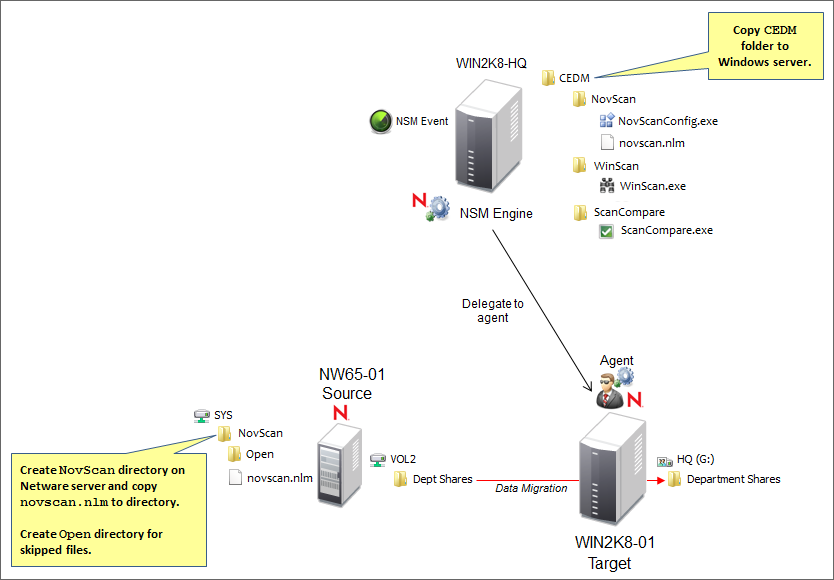
-
-
In NSMAdmin, click the tab.
-
Click .
-
Click .
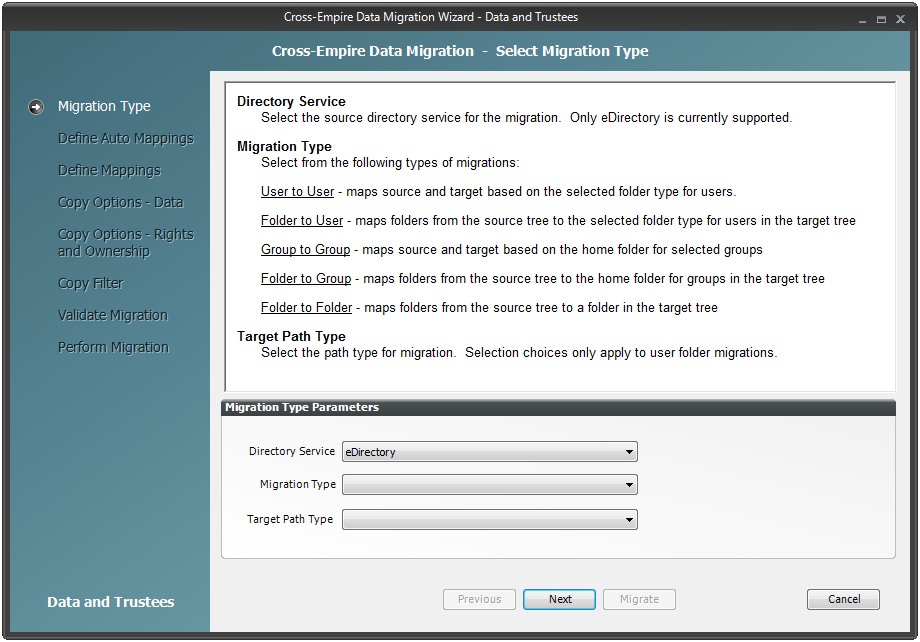
-
From the drop-down menu, select
-
Click .
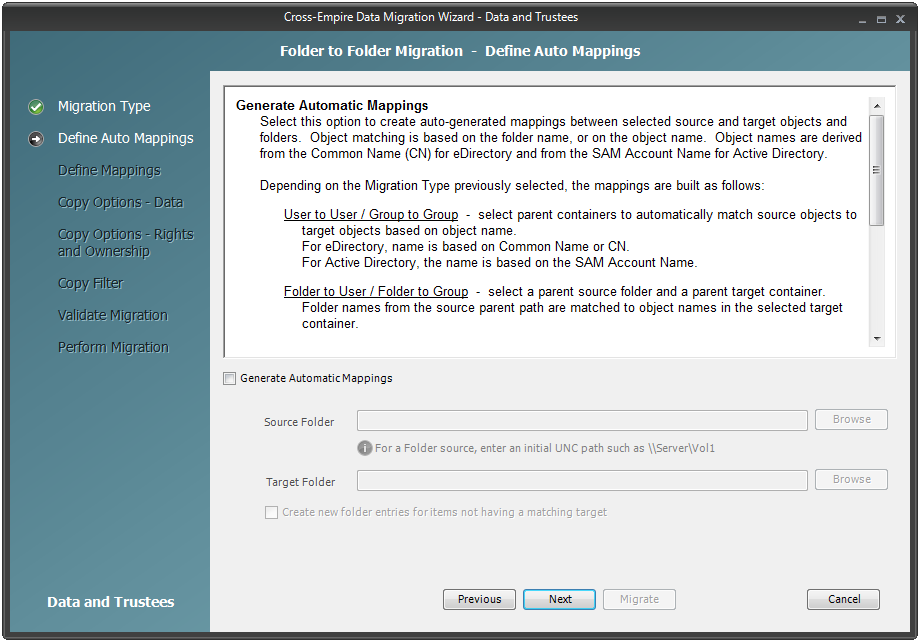
-
Fill in the following fields:
Generate Automatic Mappings: Select this check box to activate the other fields.
Source Folder: Specify an initial UNC path for a server and volume to browse.
For example, \\server_name\volume_name\ or \\ip_address\volume_name.
After a path is entered, you can click the button to browse to the folder you want.
Target Folder: Browse to select the target folder.
Create new folder entries for items not having a matching target: Selecting this check box indicates that you want Novell Storage Manager to display both matching and non-matching source and target folders.
Selecting this check box also indicates that you want Novell Storage Manager to create and populate any subfolders that do not exist in the target folder.
For example, assume that the source path at \\10.10.10.233\Vol2\Projects is being migrated to \\Corpserver\Projects and the Projects directory on the source server has a Stategov subfolder. If there is no Stategov subfolder in the target folder, a Stategov subdirectory is created to include the directory contents.
-
Click .
The Data Migration Wizard attempts to match the names of the subfolders of the source path with the subfolders of the specified target directory. If there is a match, the listed folder in the field is selected and a corresponding match is listed in the Target Folder column.
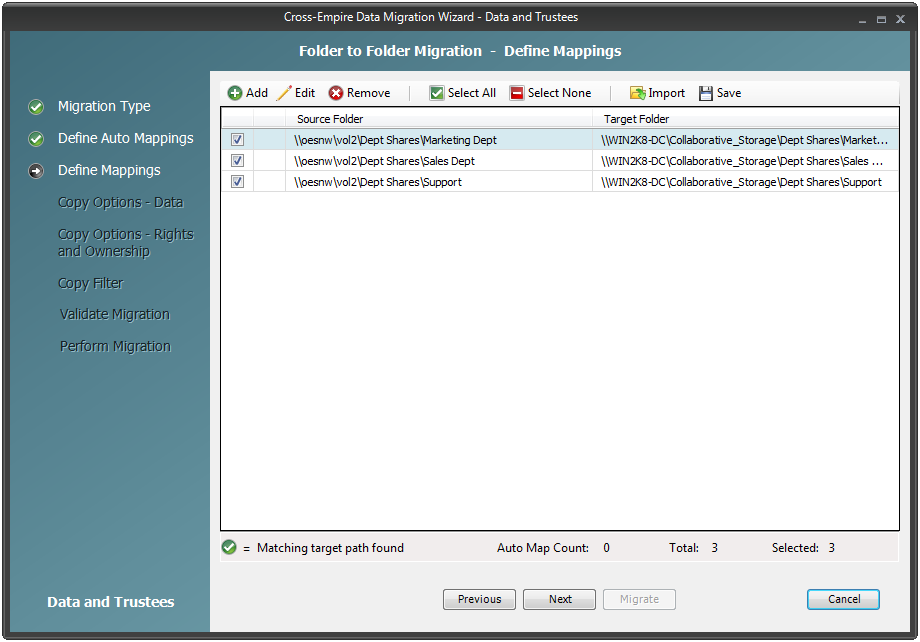
-
Specify a target folder for each source folder that is not automatically matched or that has an improperly matched subfolder by double-clicking the name to bring up the Modify Data Map Entry dialog box.

-
Remove the existing path in the field and click .
-
Locate and select the desired target folder, then click .
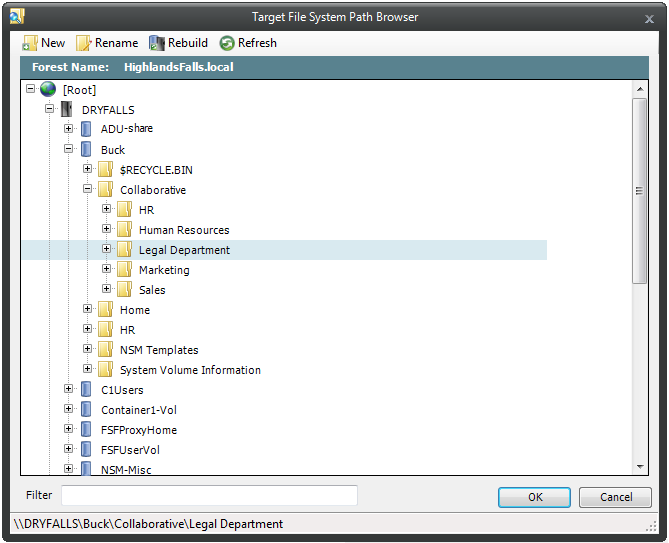
The new target path is indicated in the field of the Modify Data Map Entry dialog box.

-
Click .
-
Click the check box corresponding to the listing with the new target.
-
Click .
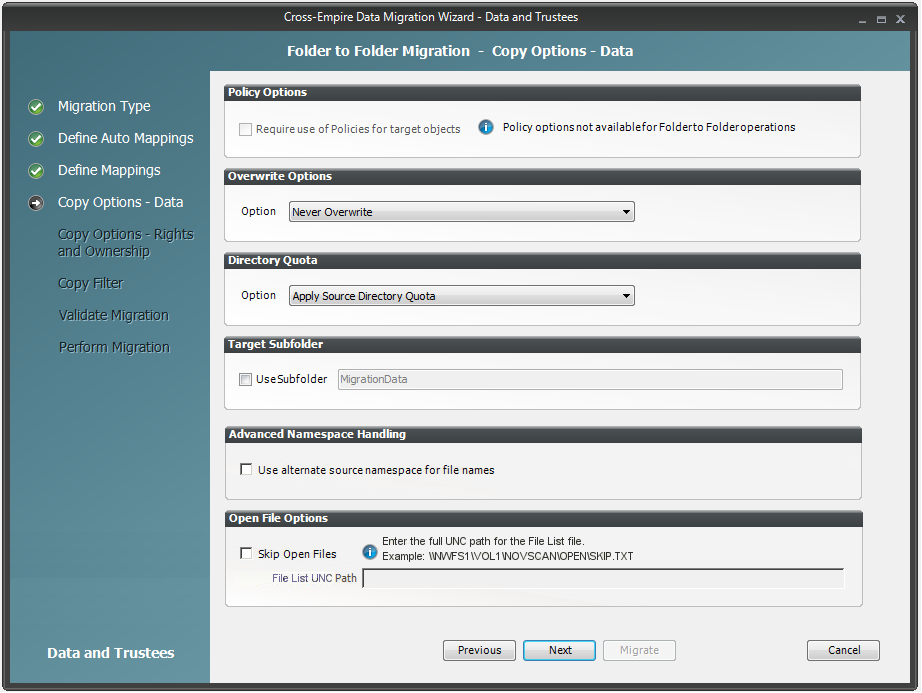
-
Fill in the following fields:
Overwrite Options: Indicate what you want to take place when duplicate filenames are encountered in the source and target.
Directory Quota: Specify how quota settings from the source Novell file system should be applied after the migration.
Target Subfolder: If you want migrated data to be placed in a subfolder, select the check box and specify the subfolder name in the field.
Advanced Namespace Handling: Selecting this check box allows the Cross-Empire Data Migration subsystem to look for alternate namespaces for files that the Novell file system cannot resolve and therefore cannot migrate.
For example, files originally saved on a Mac or Linux system might use characters that the Novell file system cannot recognize. By looking for an alternative namespace, the Novell file system might be able to resolve the problem and migrate the file.
Open File Options: If you want the Cross-Empire Data Migration subsystem to skip all open files on the network and not migrate them, select .
Selecting activates the field where you specify the name and location of the log file listing all of the open files that are skipped during the migration.
Specify the UNC path for the directory you created in Step 2.d along with a filename for the text file that will list the skipped files.
For example, \\server_name\volume_name\directory_name\Open\skip.txt
or
\\ip_address\volume_name\Open\skip.txt

The Cross-Empire Data Migration subsystem does not validate the path, so you must make sure that the path entered is correct. Otherwise, the migration fails.
-
Click .
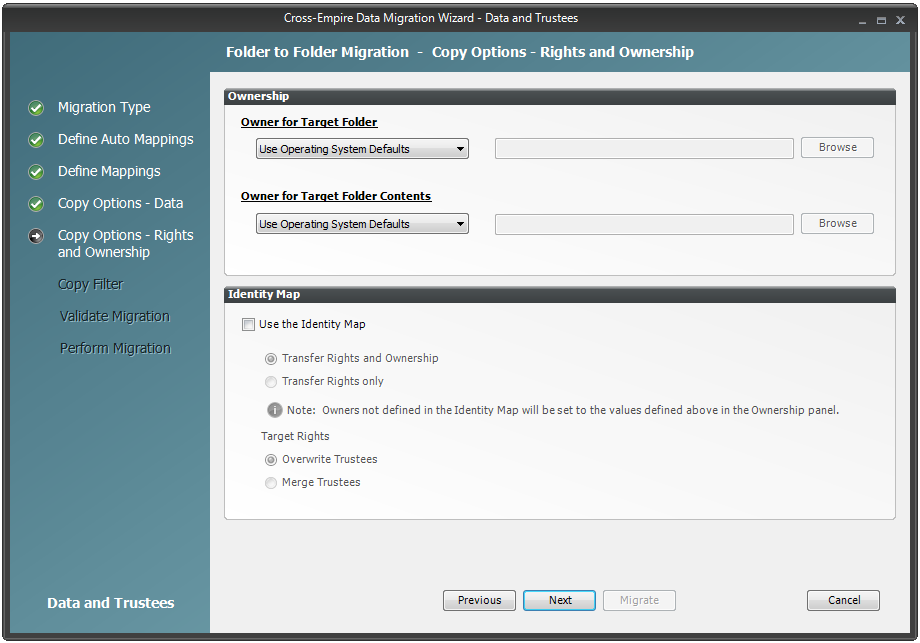
-
Fill in the following fields:
Owner for Target Folder: Use these settings to specify how ownership of the migrated folder is determined.
-
Use Operating System Defaults: This default setting allows the target Microsoft Windows Server to adjust the file ownership according to the setting on the target server.
-
Set Explicit Owner: Allows you to browse and select an object as the explicit owner of the migrated folder.
Owner for Target Folder Contents: Use these settings to specify how ownership of the migrated folder contents is determined.
-
Use Operating System Defaults: This default setting allows the target Microsoft Windows Server to adjust the file ownership according to the settings on the target server.
-
Set Explicit Owner: Allows you to browse and select an object as the explicit owner of the migrated folder.
Use the Identity Map: Select this check box if you want Novell Storage Manager to utilize the identity map you created earlier and use the corresponding IDs to copy security rights and file ownership from eDirectory to Microsoft Active Directory.
-
Transfer Rights and Ownership: Select this option if you want to transfer the file and folder security rights along with the ownership settings.
Be aware that when you transfer the ownership of a file or folder in a Windows network, you are granting the owner Full Rights, which you might not want to provide.
-
Transfer Rights Only: Select this option to transfer only the file and folder security rights.
-
Overwrite Trustees: Select this option to override any existing trustee assignments for a target file or folder with the established Novell eDirectory trustee assignments for those files and folders.
-
Merge Trustees: Select this option to merge the established Novell eDirectory trustee assignments with those of the target files or folders in Active Directory.
-
-
Click .
-
(Conditional) If you want to use a filter to include or exclude specific files, select the check box and click the button.
-
Fill in the following fields:
Description: Specify a description of the filter.
Action: From the drop-down menu, select either or , based on whether the filter specifies to migrate files or folders or to ignore them.
Files, Folders: Specify if the filter applies to files or folders.
Masks: List the file types to migrate or ignore.
-
Specify any additional filter criteria in the menus and fields that remain.
For a detailed explanation of this region of the dialog box, see Section 5.5.8, Setting Vault Rules.
-
Click .
-
-
Click .
shows the result of certain checks that can be run prior to the migration. The column shows the status of the validation checks. If errors are displayed, you can choose to correct those errors prior to running the migration.
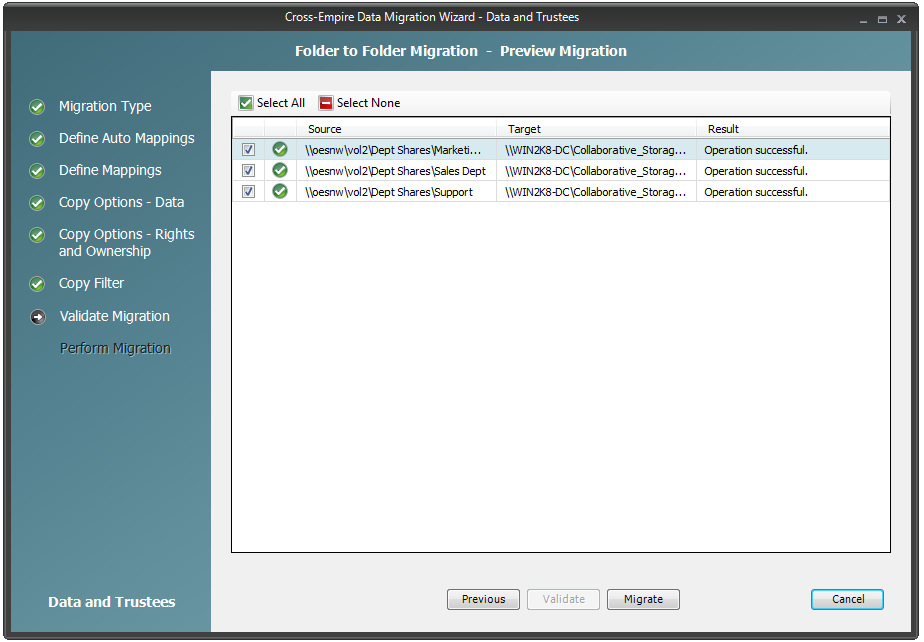
-
(Conditional) Take any necessary action in the Active Directory target and then re-run the Data Migration Wizard.
-
Click .
A page appears with details of the data migration events that are queued for processing. To view the status of migration events, click . For more information on Pending Events, see Section 12.1.6, Pending Events.
-
Do one of the following:
-
If you skipped some files to migrate later, click and then continue with Migrating Skipped Files.
-
If you have migrated all of your data, click .
You are now finished with the folder to folder migration.
-
Migrating Skipped Files
The second phase of a folder to folder data migration is conducted when all of the users are logged off the network, so all network files are closed.
-
Have everyone log off the network so that there are no open files on the source NetWare or Open Enterprise Server machines.
-
Open the text file that you created in Step 16 and view the files that were skipped.
Do not make any changes to the file. Doing so causes errors during the migration.
-
Save a copy of the text file.
For example, if you named the file skip.txt, save a copy as skip_copy.txt.
After the Cross-Empire Data Migration subsystem migrates the skipped files, it deletes the text file. You can use the copy to verify that the files were migrated.
-
In NSMAdmin, click the tab.
-
Click .
-
Click .

-
From the drop-down menu, select .
-
Click .
-
Skip the Automatic Mappings settings by clicking .
-
On the Define Mappings wizard page, click .
-
In the Add Data Entry dialog box, browse to and select the source and target.
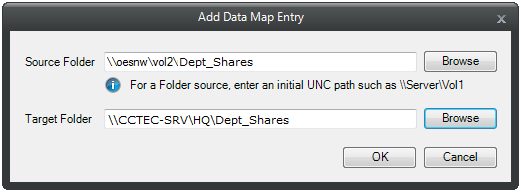
-
Click .
-
On the Define Mappings wizard page, verify the source folder and the destination folder and click .

-
On the Copy Options - Data wizard page, from the Option drop-down menu in the region, select and click .

-
(Optional) On the Copy Options - Rights and Owners wizard page, from the drop-down menu of the region, select
-
(Conditional) If you chose to set an explicit owner for the folder, click the corresponding button and browse to specify an owner for the target folder.
-
(Optional) From the drop-down menu of the region, select .
-
(Conditional) if you chose to set an explicit owner for the folder contents, click the corresponding button and browse to specify an owner for the target folder contents.
-
Select the check box and click .
-
On the Copy Filter wizard page, specify the UNC path to the file you created in Step 16.
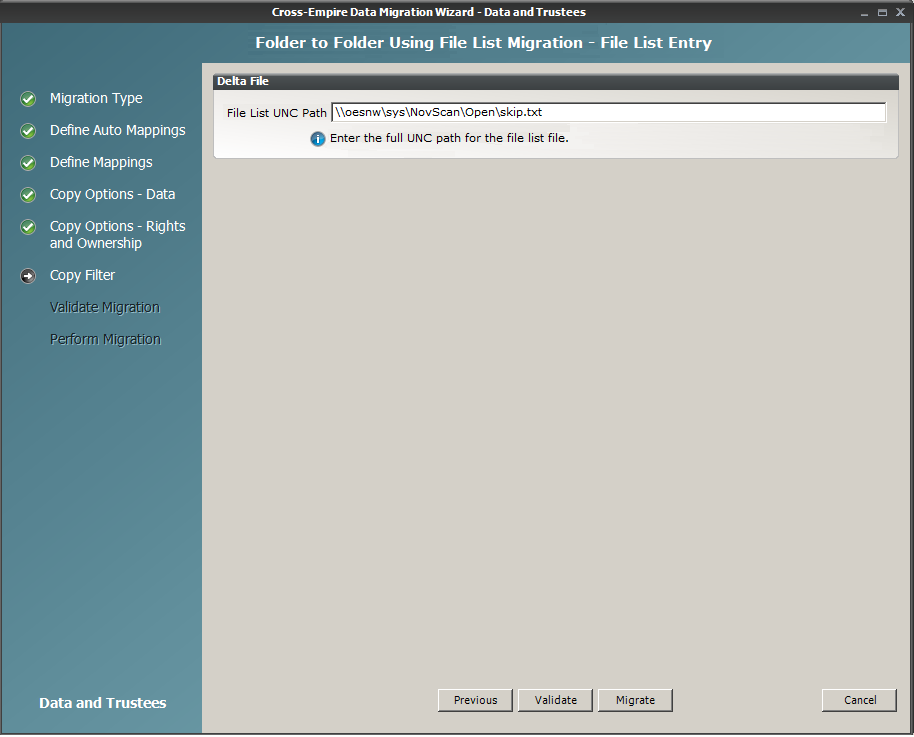
-
Click to confirm that the path is correct.
-
Click .
The skipped files are migrated and the text file that you created in Step 16 is deleted.
-
Click .
-
Continue with Creating a Job File to Scan the Source Server for New or Modified Folders and Files.
Creating a Job File to Scan the Source Server for New or Modified Folders and Files
With the skipped files migrated, you are now ready to create a job file so the NovScanConfig utility can scan the source server.
-
From the CEDM folder that you copied in Step 2.a, open the NovScan folder and launch the NovScanConfig utility.
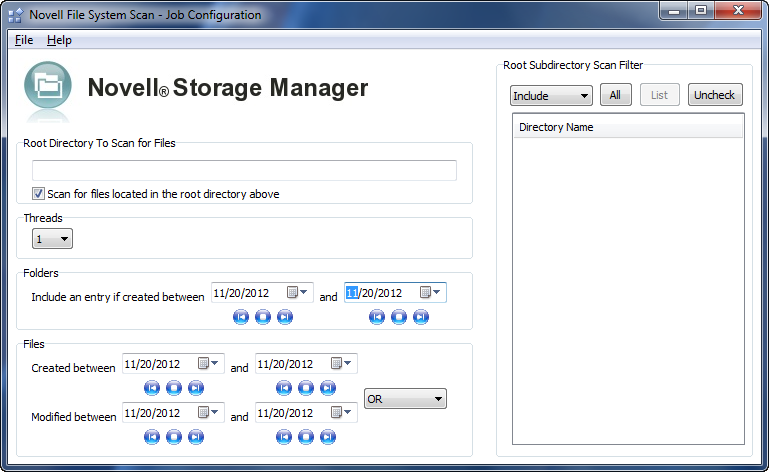
-
In the field, enter the UNC path to the directory on the NetWare or Open Enterprise Server you want to scan.
For example: \\oesnw\vol2\dept shares
-
In the region, click the button, then click the button to include all of the subdirectories, including new subdirectories, in the directory you specified in Step 2.
-
Ensure that the drop-down menu listing displays .
-
From the drop-down menu, select the thread count you want for the migration.
-
In the region, in the first date entry, select the date when you migrated the closed files.
This specifies that the job file created by the NovScanCofig utility lists all folders that are new or modified since midnight of the selected date.
-
In the second date entry, select a concluding date for the range.
-
In the region, in the date entry pertaining to , select the date when you migrated the closed files.
This specifies that the job file lists all files that have been created since midnight of the selected date.
-
In the second date entry for , select a concluding date for the range.
-
Ensure that the drop-down menu listing displays .
-
In the date entry for , select the date when you migrated the closed files.
This specifies that the job file lists all files that have been modified since midnight of the selected date.
-
In the second date entry for , select a concluding date for the range.
-
From the menu, select and save the file as a text file with a .job extension in the NovScan folder that you created in Step 2.b.
For example: vol2_dept.job
-
When you are notified that the text file has been saved, click .
-
Close the NovScanConfig utility.
-
Continue with Using the NovScan NLM to Run the Job File.
Using the NovScan NLM to Run the Job File
-
At the NetWare server, load the novscan.nlm from the path that you established in Step 2.b.

-
Select either or .
If you are scanning an Open Enterprise Server, select and then log in as an administrator so that this NetWare server can make a connection to the remote Open Enterprise Server machine.
If you are scanning a local NetWare server, select .
-
At the NetWare console, run the job file that you created in Step 13.
The following commands can be used at the NetWare console command prompt to perform actions with the NovScan NLM:
-
JOB=path to job file on local server
The following example is a NovScan NLM directive to run a job file:
SERVER65: novscan job=sys:novscan\scanvol1.job
-
STOPSCAN
The NovScan NLM can run one scan job at a time. You might want to stop a scan that is in progress. The following example is a directive for the NovScan NLM to stop a scan that is running.
SERVER65: novscan stopscan
-
SHOW=ON/OFF
The NovScan NLM by default shows the names of the directories as they are being scanned. These scanned directories are also logged. You can turn the display and logging on or off by using this parameter. For example:
SERVER65: novscan show=on
SERVER65: novscan show=off
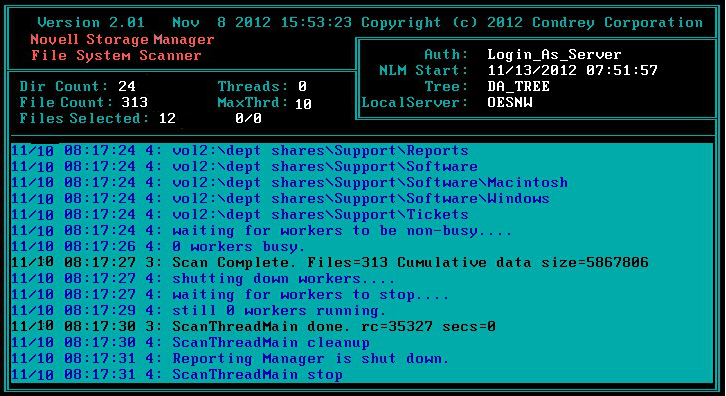
The field displays the number of files created or modified since the first phase of the migration.
-
-
From your Windows workstation, go to the NovScan folder that you created in Step 2.b.
-
Observe that a new text file has been created with the same name as the job file that you created in Step 13 but with the addition of -FLIST.
This new file is a list of all the new and modified files since the first phase of the migration. If you open this file, do not make any changes, because this causes errors during the next phase of the migration.
-
Save a copy of the text file.
For example, if the file is named vol2_dept-FLIST.job, save a copy as vol2_dept-FLIST_copy.job.
-
Continue with Migrating the New and Modified Files.
Migrating the New and Modified Files
Migrating all of the files that are new or modified since the first phase of the folder to folder migration follows the same process as migrating the skipped files. The only difference is that you enter a different UNC path.
-
In NSMAdmin, click the tab.
-
Click .
-
Click .

-
From the drop-down menu, select .
-
Click .
-
Skip the Automatic Mappings settings by clicking .
-
On the Define Mappings wizard page, click .
-
In the Add Data Entry dialog box, browse to and select the source and target.

-
Click .
-
On the Define Mappings wizard page, verify the source folder and the destination folder and click .

-
On the Copy Options - Data wizard page, from the drop-down menu in the region, select , then click .

-
(Optional) On the Copy Options - Rights and Owners wizard page, from the drop-down menu of the region, select .
-
(Conditional) If you chose to set an explicit owner for the folder, click the corresponding button and browse to specify an owner for the target folder.
-
(Optional) From the drop-down menu of the region, select .
-
(Conditional) If you chose to set an explicit owner for the folder contents, click the corresponding button and browse to specify an owner for the target folder contents.
-
Select the check box and click .
-
On the Copy Filter wizard page, specify the UNC path to the new text file that you viewed in Step 5.
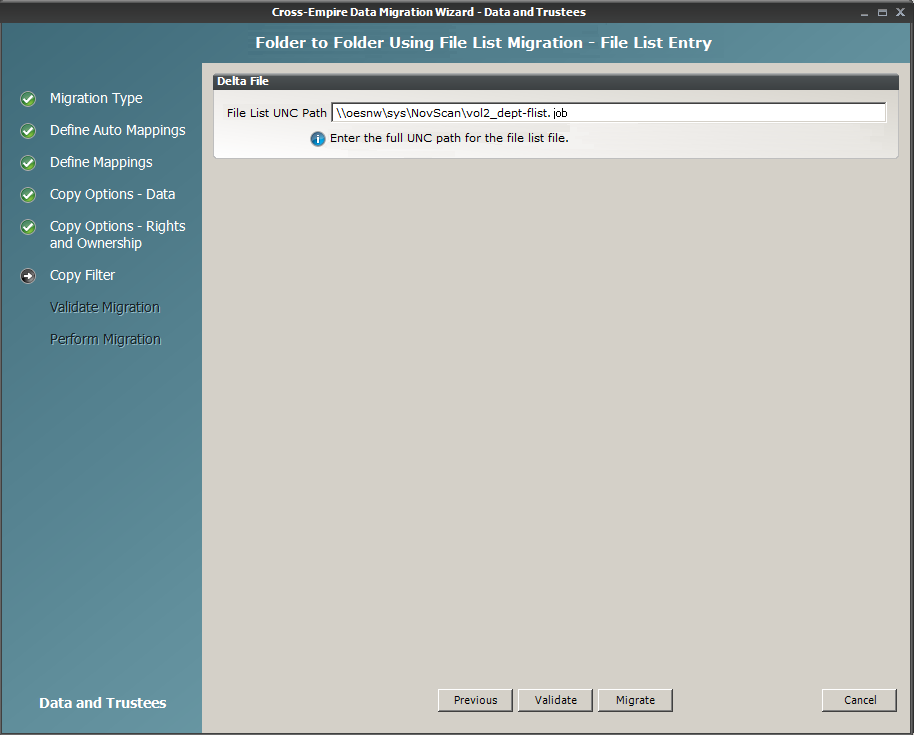
-
Click to confirm that the path is correct.
-
Click .
The new and modified files are migrated and the text file that you viewed in Step 5 is deleted.
-
Click .
-
Continue with Creating a Job File to Scan the Source Server for All Folders and Files.
Creating a Job File to Scan the Source Server for All Folders and Files
-
From the CEDM folder that you copied in Step 2.a, open the NovScan folder and launch the NovScanConfig utility.

-
In the field, enter the UNC path to the directory on the NetWare or Open Enterprise Server you want to scan.
For example: \\oesnw\vol2\dept shares
-
In the region, click the button, and then click the button to include all of the subdirectories in the directory you specified in Step 2.
-
Ensure that the drop-down menu listing displays .
-
From the drop-down menu, select the thread count you want for the migration.
-
In the region, in the first date entry, select the left button, which sets the date to 1/1/1970.
-
In the second date entry, select the right button, which sets the date to 12/31/2036.
This range of dates ensures that you identify all folders that exist in the specified path.
-
In the region, in the date entry for , select the left button, which sets the date to 1/1/1970.
-
In the second date entry for , select the right button, which sets the date to 12/31/2036.
Again, this range of dates ensures that you identify all files created in the specified path.
-
Ensure that the drop-down menu listing displays .
-
Set the date range for modified files to the same dates you used for new folders and new files.
-
From the menu, select and save the file as a text file with a .job extension in the NovScan folder that you created in Step 2.b.
For example: vol2_dept-all.job
-
When you are notified that text file has been saved, click .
-
Close the NovScanConfig utility.
-
Continue with Using the NovScan NLM to Run the Job File.
Using the NovScan NLM to Run the Job File
-
At the NetWare server, load the novscan.nlm from the path that you established in Step 2.b.

-
Select either or .
If you are scanning an Open Enterprise Server, select and then log in as an administrator so that this NetWare server can make a connection to the remote Open Enterprise Server machine.
If you are scanning a local NetWare server, select .
-
At the NetWare console, run the job file that you created in Step 12.
The following commands can be used at the NetWare console command prompt to perform actions with the NovScan NLM:
-
JOB=path to job file on local server
The following example is a NovScan NLM directive to run a job file:
SERVER65: novscan job=sys:novscan\scanvol1.job
-
STOPSCAN
The NovScan NLM can run one scan job at a time. You might want to stop a scan that is in progress. The following example is a directive for the NovScan NLM to stop a scan that is running.
SERVER65: novscan stopscan
-
SHOW=ON/OFF
The NovScan NLM by default shows the names of the directories as they are being scanned. These scanned directories are also logged. You can turn the display and logging on or off by using this parameter. For example:
SERVER65: novscan show=on
SERVER65: novscan show=off
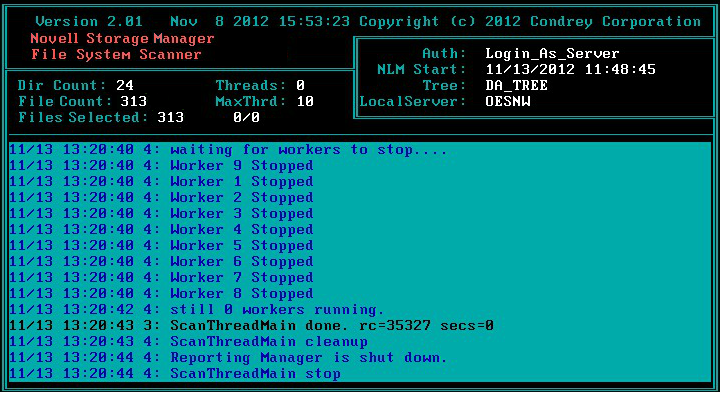
The field now displays the total number of files.
-
-
From your Windows workstation, go to the NovScan folder that you created in Step 2.b.
-
Observe that a a new text file has been created with the same name as the job file that you created in Step 12 but with the addition of -FLIST.
This new file is a list of all the files from the specified path. If you open this file, do not make any changes, because this can cause errors during the file comparison.
-
Continue with Scanning the Target Server for All Folders and Files.
Scanning the Target Server for All Folders and Files
-
From the CEDM folder that you copied in Step 2.a, open the WinScan folder and launch the WinScan utility.
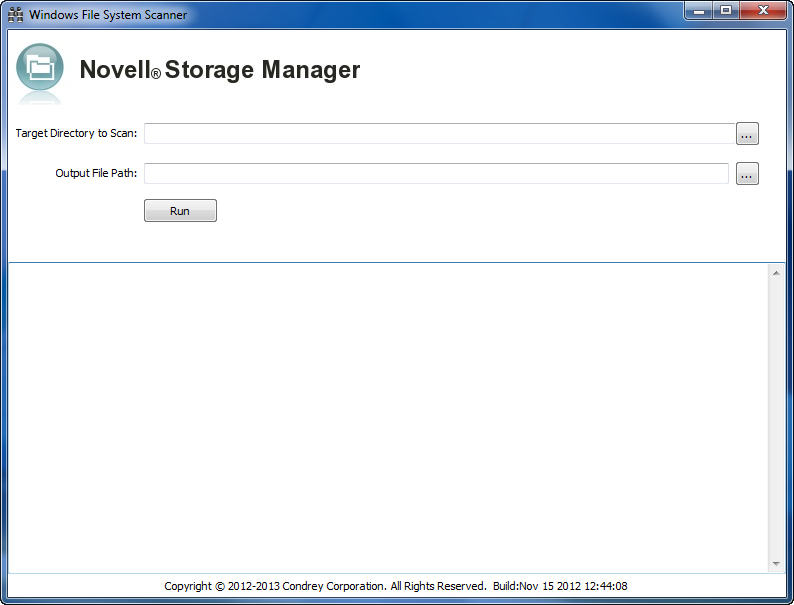
-
Click the browse button for the field and browse to select the target folder.
-
Click the browse button for the field, browse to the WinScan folder, and in the field of the Open dialog box, specify a filename with a .txt extension.
For example, target-all.txt
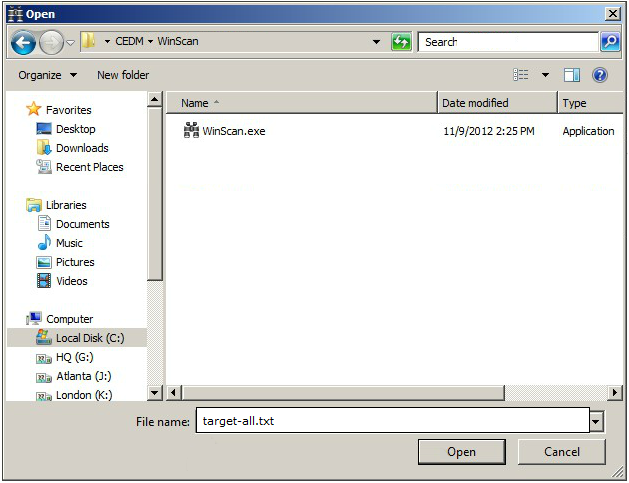
-
Click .
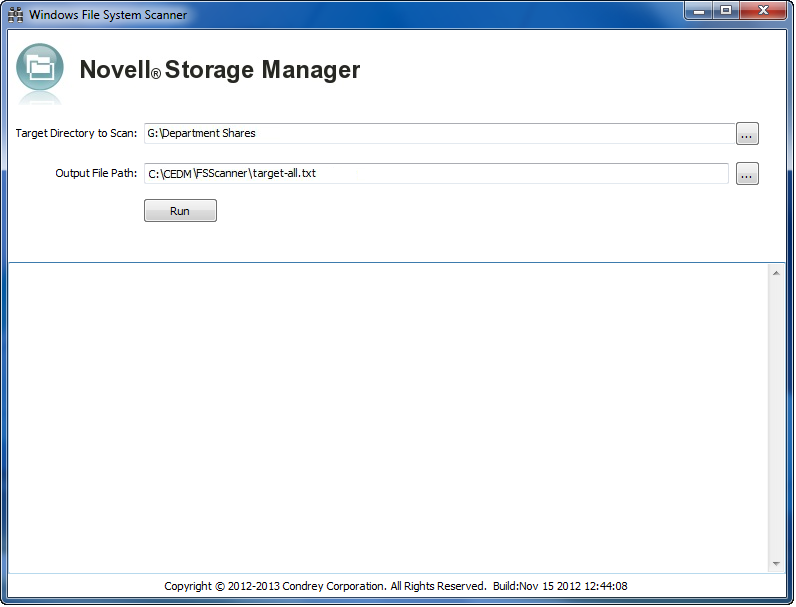
-
Click .
All of the files for the target path are displayed.
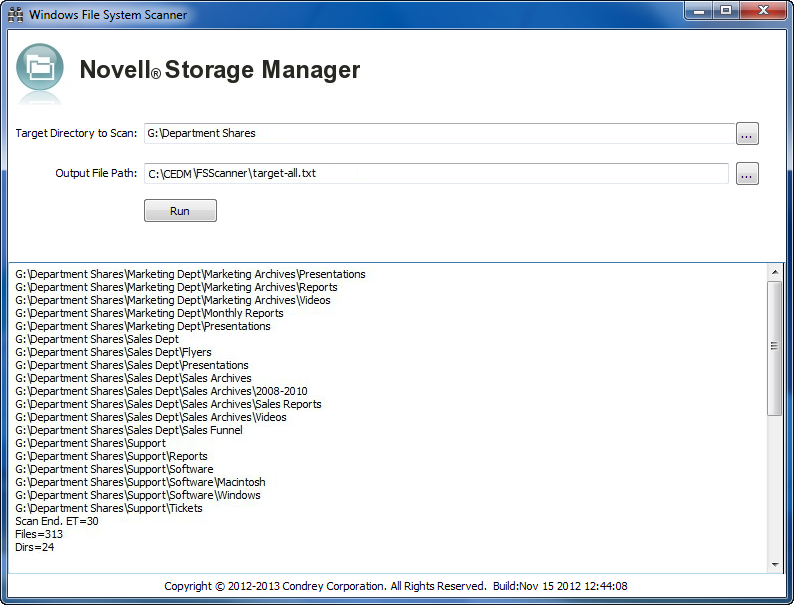
-
Close the WinScan utility.
-
Continue with Comparing the Source and Target Lists.
Comparing the Source and Target Lists
With file lists generated from the source and target servers, you can now compare the two lists by using the ScanCompare utility.
-
From the CEDM folder that you copied in Step 2.a, open the ScanCompare folder and launch the ScanCompare utility.
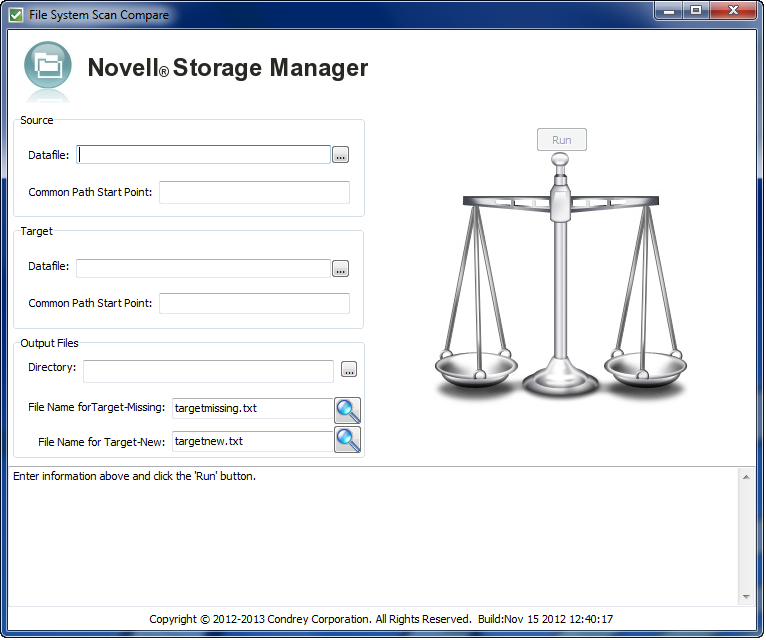
-
In the region, click the browse button for the field, then browse to and select the.job text file that you observed in Step 5.
-
In the region, click the browse button for the field, then browse to and select the text file that you created in Step 3.
After you have specified the source and target files, the fields automatically display the first line of each file.
The next task is to specify a common starting point for the file comparison.
-
In the region, edit the path so that it concludes with the directory name containing the subfolders and files that you migrated earlier.
For example: \\oesnw\vol2\dept shares
-
In the region, edit the path so that it concludes with the folder name containing the subfolders and files that were migrated earlier.
For example: G:\Department Shares\
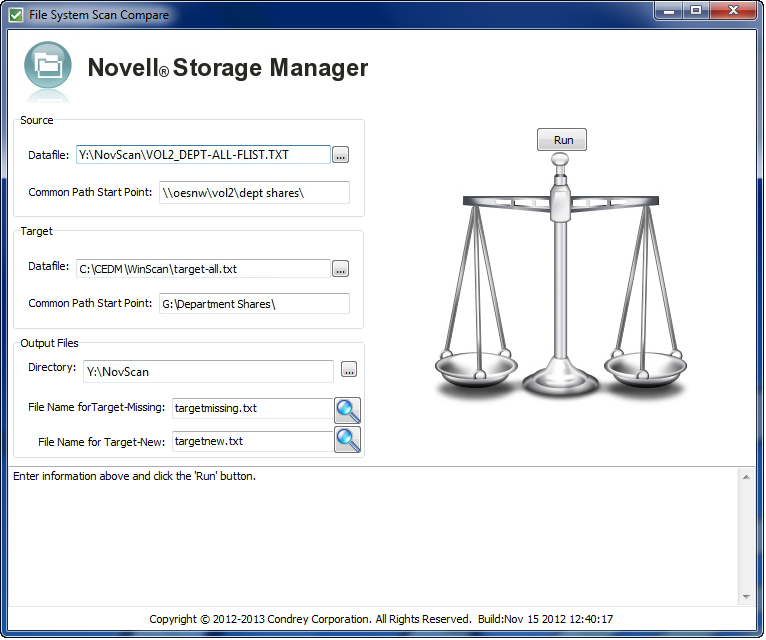
-
Click .
The ScanCompare utility compares the files and displays the findings.
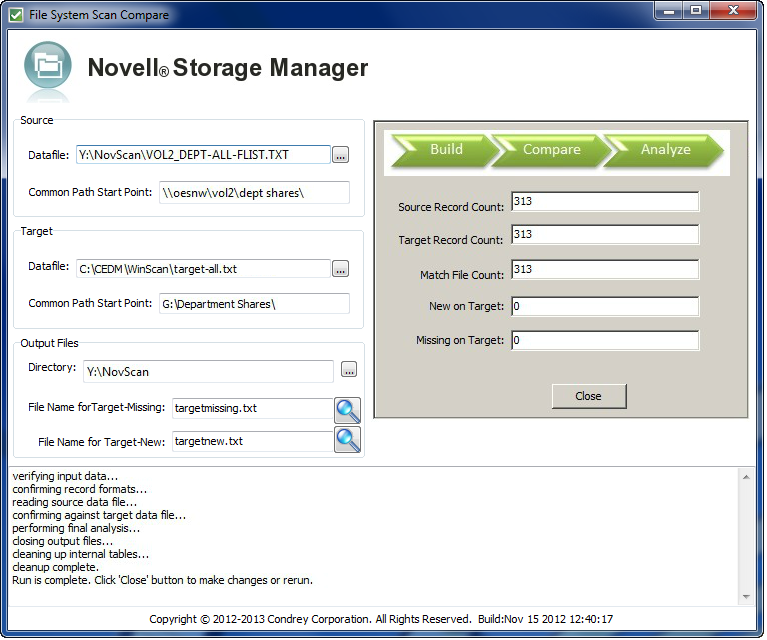
-
Use the findings to verify that all files were migrated.
If the or fields display entries other than zero, you will need to review the targetnew.txt or targetmissing.txt files to determine the cause of the source and target record count discrepancy.
You are now finished with both phases of the folder to folder migration.
11.12.2 Creating a Target Folder in the Data Migration Wizard
-
Make sure you have completed the prerequisites and have created a migration proxy account.
For more information on the prerequisites, see Section 11.3, Prerequisites. For more information on creating a migration proxy account, see Section 11.4, Creating the Migration Proxy Account.
-
(Conditional) If you want to migrate closed files now and skip some files to migrate later, complete the following steps:
-
From the Novell Storage Manager ISO image, copy the CEDM folder to the Windows target server.
-
On each NetWare server from which you are going to migrate data, create a NovScan directory.
-
From the Novell Storage Manager ISO image, copy the novscan.nlm file from the Utilities\CEDM\NovScan folder to the NovScan directory you created in Step 2.b.
-
In the new NovScan directory, create a new subdirectory and name it Open.
Figure 11-2 Summary of Substeps to Complete.

-
-
In NSMAdmin, click the tab.
-
Click .
-
Click .

-
From the drop-down menu, select .
-
Click .

-
Click .
-
Click .
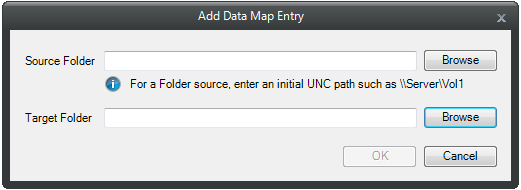
-
In the field, specify an initial UNC path for a server and volume to browse.
For example, \\server_name\volume_name\ or \\ip_address\volume_name.
After a path is entered, you can click the button to browse to the folder you want.
-
Click the button that corresponds to the field to locate the share where you want to create the new folder for the migrated data.
-
Right-click the share, select , name the new folder, and click .
-
Click to close the Target File System Path Browser.
-
In the Add Data Map Entry dialog box, click the button that corresponds to the field again, browse to and select the new folder, then click .
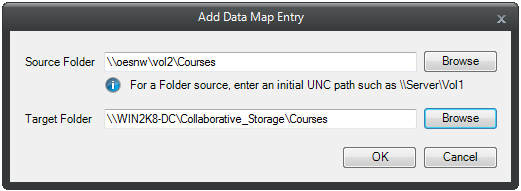
-
Click .
The defined source and target mappings are displayed.
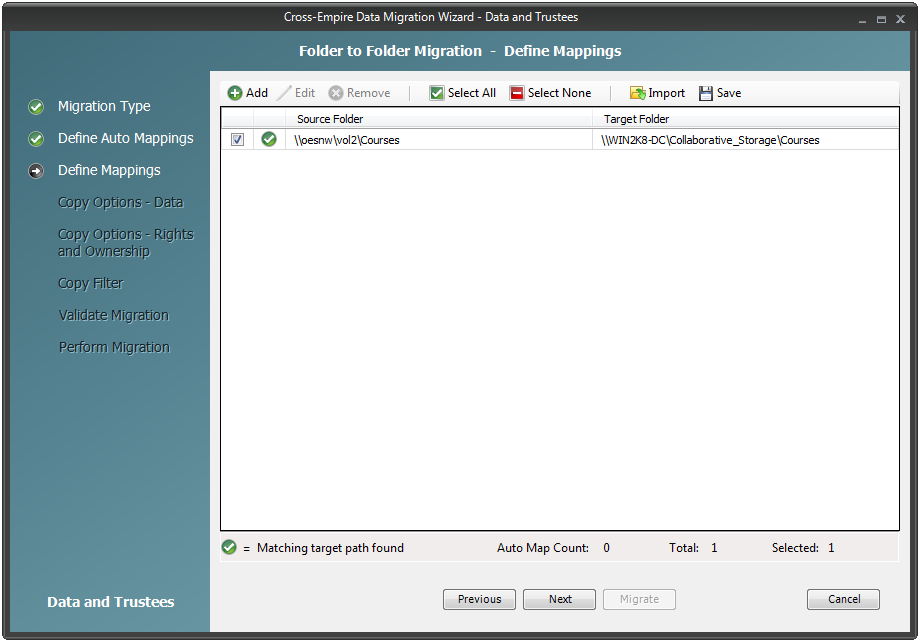
-
Click .

-
Fill in the following fields:
Overwrite Options: Indicate what you want to take place when duplicate filenames are encountered in the source and target.
Directory Quota: Specify how quota settings from the source Novell file system should be applied after the migration.
Target Subfolder: If you want migrated data to be placed in a subfolder, select the check box and specify the subfolder name in the field.
Advanced Namespace Handling: Selecting this check box allows the Cross-Empire Data Migration subsystem to look for alternate namespaces for files that the Novell file system cannot resolve and therefore cannot migrate.
For example, files originally saved on a Mac or Linux system might use characters that the Novell file system cannot recognize. By looking for an alternative namespace, the Novell file system might be able to resolve the problem and migrate the file.
Open File Options: If you want the Cross-Empire Data Migration subsystem to skip all open files on the network and not migrate them, select .
Selecting activates the field where you specify the name and location of the log file listing all of the open files that are skipped during the migration.
Specify the UNC path for the directory you created in Step 2.d along with a filename for the text file that will list the skipped files.
For example, \\server_name\volume_name\directory_name\Open\skip.txt
or
\\ip_address\volume_name\Open\skip.txt

The Cross-Empire Data Migration subsystem does not validate the path, so you must make sure that the path entered is correct. Otherwise, the migration fails.
-
Click .

-
Fill in the following fields:
Owner for Target Folder: Use these settings to specify how ownership of the migrated folder is determined.
-
Use Operating System Defaults: This default setting allows the target Microsoft Windows Server to adjust the file ownership according to the setting on the target server.
-
Set Explicit Owner: Allows you to browse and select an object as the explicit owner of the migrated folder.
Owner for Target Folder Contents: Use these settings to specify how ownership of the migrated folder contents is determined.
-
Use Operating System Defaults: This default setting allows the target Microsoft Windows Server to adjust the file ownership according to the settings on the target server.
-
Set Explicit Owner: Allows you to browse and select an object as the explicit owner of the migrated folder.
Use the Identity Map: Select this check box if you want Novell Storage Manager to utilize the identity map you created earlier and use the corresponding IDs to copy security rights and file ownership from eDirectory to Microsoft Active Directory.
-
Transfer Rights and Ownership: Select this option if you want to transfer the file and folder security rights along with the ownership settings.
Be aware that when you transfer the ownership of a file or folder in a Windows network, you are granting the owner Full Rights, which you might not want to provide.
-
Transfer Rights Only: Select this option to transfer only the file and folder security rights.
-
Overwrite Trustees: Select this option to override any existing trustee assignments for a target file or folder with the established Novell eDirectory trustee assignments for those files and folders.
-
Merge Trustees: Select this option to merge the established Novell eDirectory trustee assignments with those of the target files or folders in Active Directory.
-
-
Click .
-
(Conditional) If you want to use a filter to include or exclude specific files, select the check box and click the button.
-
Fill in the following fields:
Description: Specify a description of the filter.
Action: From the drop-down menu, select either or , based on whether the filter specifies to migrate files or folders or to ignore them.
Files, Folders: Specify if the filter applies to files or folders.
Masks: List the file types to migrate or ignore.
-
Specify any additional filter criteria in the menus and fields that remain.
For a detailed explanation of this region of the dialog box, see Section 5.5.8, Setting Vault Rules.
-
Click .
-
-
Click .
shows the result of certain checks that can be run prior to the migration. The column shows the status of the validation checks. If errors are displayed, you can choose to correct those errors prior to running the migration.
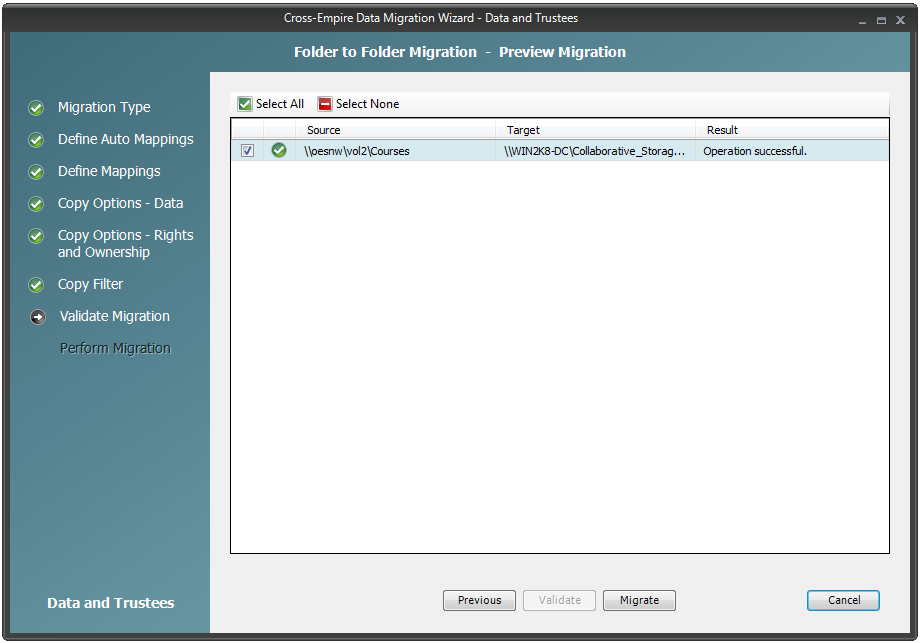
-
(Conditional) Take any necessary action in the Active Directory target and then re-run the Data Migration Wizard.
-
Click .
A page appears with details of the data migration events that are queued for processing. To view the status of migration events, click . For more information on Pending Events, see Section 12.1.6, Pending Events.
-
Do one of the following:
-
If you skipped some files to migrate later, click and then continue with Migrating Skipped Files.
-
If you have migrated all of you data, click .
You are now finished with the folder to folder migration.
-